by Ken Lain, the mountain gardener
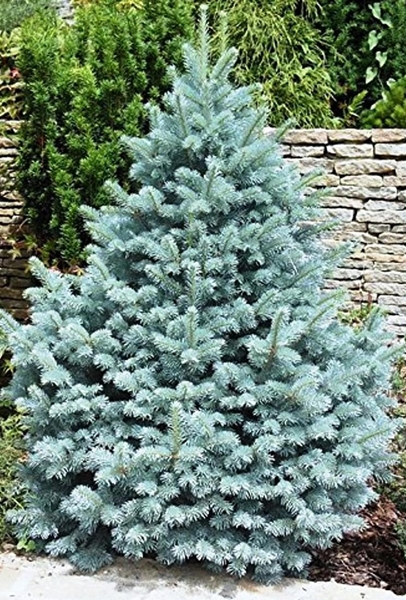
If the older needles on your evergreens are turning yellow and dropping, don’t worry. Nothing’s wrong, and they’re not all dying. We define them as “evergreens,” such as pine, arborvitae, spruce, and juniper, but their old needles in late summer and fall do yellow and begin to drop. For those new to mountain gardening with conifers, this natural cycle can be alarming.
Don’t have time to view the entire article, view the highlights below:
- Needle dropping on the inside branches of evergreens is to be expected through autumn.
- Brown needles at the tips and of new growth indicate a dying tree.
- Evergreens naturally lose some needles to reduce winter snow and ice damage.
- Evergreen shrubs like Red Tipped photinias, rhododendrons, and euonymuses do the same.
- Feed with 7-4-4 All Purpose Food and Aluminum Sulfate in October for intense spring colors.
- Evergreen trees are heavy and awkward to plant. It pays to have Watters planting service install them.
- Now through October is the best time to plant new evergreens.
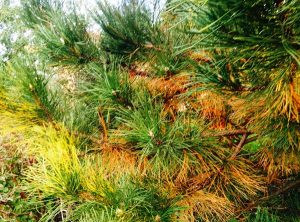
This phenomenon should not be confused with browning at the tips or overall yellowing/browning that can happen at other times of the year. The more severe browning of evergreens is often caused by winter desiccation, the effects of roadside salts, pests and diseases, or drought. When needles drop from the branch tips that are dropping back toward the trunk, the tree is almost certainly dead, and will not recover. Once a mountain conifer drops its needles, it rarely comes back to life. However, before digging up your stressed evergreen and planting another, visit us for a proper autopsy and verification. Here’s more on how to help Sick and Dying Trees.
Gardeners new to the area have been noticing the seasonal effect, especially on their Austrian and Ponderosa pines as needles turn to gold or rusty-brown and litter the area around the trees. This needle-drop is a normal part of an evergreen’s life cycle. The drop rate varies by tree and often is accelerated by environmental stresses like dry conditions, grub and gopher pressure, or pest infestation.
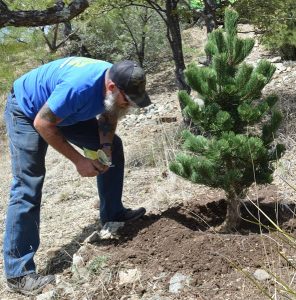
Before you call an arborist from Jonny’s Tree & Landscaping, first inspect your trees or bring an example into the garden center for a closer inspection under the microscope. Look at a branch that has new growth to identify where along the branch it has fading foliage.
On a Michigan State University Extension factsheet, I found this helpful info explaining the natural aging and shedding cycle:
The losses should generally be from the inside out, not at the branch tips. Inner needles are the oldest, and as they age, they photosynthesize less effectively and eventually are shed, their functions assumed by newer needles farther out on the branches. Evergreens are smart; they shed these older needles to reduce possible winter snow loads that can gather on the new, longer branches that grew out in spring. The extra needles could quickly load up with too much snow, causing torn and broken limbs. Again, this varies by species, but most Arizona evergreens have a similar needle-drop period.
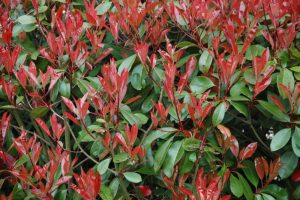
This same leaf drop is also witnessed on broadleaf evergreens like Red Tipped Photinias, Rhododendrons, and Euonymus pushing off older, damaged, or useless foliage this time of year. Not to worry; as long as this year’s new growth has excellent color and looks healthy. It is essential to keep this leaf and needle-drop cleaned up for health and fire reasons. Diseases like molds and mildews are protected in winter by this leaf litter at the base of the plant and re-infect your shrubs next spring. Now, a few inches of needles around the bases of evergreen trees insulate the roots and reduce water needs for healthier plants, but more than that can cause a wildfire hazard in the landscape. For more on pine needle clean-up visit my article on Are Pine Needles Good or Bad for the Garden?
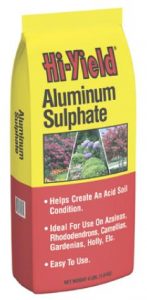
Insider Tip – Here’s how to get the best blue, green, and silver colors out of your evergreens: Most conifers produce new growth only in the spring season. Next year’s bud, aka candle growth, has already begun. The stage for the best-colored evergreens is set in the fall of the year. By the end of October feed the entire drip line, or the garden soil under the longest branches of the plant, with 7-4-4 All Purpose Food, but here’s the real secret . . . at the same time spread on a light dose of Aluminum Sulfate. This extra dose of color-enhancing mineral really intensifies the natural colors of mountain evergreens.

Planting & Delivery Service – Autumn is the best time to plant a new evergreen. Spruce, pine, cypress, and juniper are quite bulky and heavy and often inflict bodily damage to the gardener. After planting a mature evergreen tree, it’s possible to look like you’ve been in a catfight . . . and the cat won! So consider having the garden center plant it for you; you will find the money well spent.
Of course, the larger the tree, the bigger the hole and the more it costs to plant, but it’s worth the expense. To plant an average size tree that stands head high costs about $100, and includes the jackhammer, warranty, labor, and all the materials to plant it right.
Until next issue, I’ll be here at Watters Garden Center helping gardeners get their conifers ready for the seasons ahead.
Ken Lain can be found throughout the week at Watters Garden Center, 1815 W. Iron Springs Rd in Prescott, or contacted through his web site at WattersGardenCenter.com or FB.com/WattersGardenCenter .

